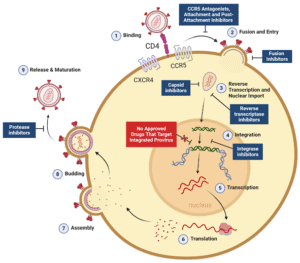Back to: MICROBIOLOGY 300 LEVEL
Welcome to class!
Hey there, my superstar learner! I’m excited to be with you again today. You’ve been showing up with so much brilliance and dedication—it’s inspiring. Now imagine this: some viruses are like uninvited guests who not only sneak into your house but find a secret room and live there quietly for years without you knowing. That’s exactly what we’re going to talk about today—how viruses manage to stay hidden in the body through persistence and latency. Let’s walk through it together.
Mechanisms Of Viral Persistence And Latency
Have you ever wondered why some viral infections come and go quickly, like a common cold, while others stay in the body for life—sometimes without causing any symptoms for years? That’s because some viruses are clever. Instead of being completely destroyed by your immune system, they find ways to stay hidden or inactive in your cells.

This ability to “stay behind” without being noticed is known as persistence, and when they go totally quiet but still live inside you, we call that latency. Understanding how this happens is important for finding long-term treatments and even cures for diseases like HIV and Herpes.
Viral Persistence: What It Means
Viral persistence is when a virus is not fully cleared from the body and continues to exist for long periods—sometimes for life. There are different ways this can happen:
Chronic Persistent Infections
The virus keeps replicating at low levels over time, and symptoms may continue or come and go.
Example: Hepatitis B and C—these viruses stay in the liver and can cause long-term damage.
Slow Infections
These viruses replicate very slowly, and the symptoms may take years to appear.
Example: Measles virus causing subacute sclerosing panencephalitis (SSPE) years after infection.
Latency: The Silent Strategy
Latency is a special form of persistence where the virus enters the host’s cells and “goes to sleep.” It doesn’t replicate or cause symptoms, but it can reactivate later—especially when the immune system is weak or the body is stressed.
Herpes Simplex Virus (HSV):
After the initial infection (like a cold sore), the virus hides in nerve cells and becomes latent. During stress or illness, it can reactivate and cause new sores.
HIV:
HIV can insert its genetic material into the DNA of immune cells and remain hidden—even when the patient is taking treatment. This is one reason why curing HIV is so difficult.
Varicella Zoster Virus:
After causing chickenpox in childhood, it can stay latent in nerve cells and reactivate later as shingles.
Mechanisms Behind Viral Latency and Persistence
So how do viruses pull this off? Let’s break it down:
Hiding from the Immune System:
Some viruses reduce the expression of their proteins so the immune system can’t detect them.

Integration into Host DNA:
Viruses like HIV insert their genetic material into host DNA and remain dormant.
Infection of Immune-privileged Sites:
Certain areas in the body like the brain and spinal cord are hard for the immune system to access. Some viruses hide there.
Regulating Host Cell Functions:
Viruses can control host cell pathways to avoid triggering an immune response or cell death.
Think of latency like a student who attends class once, then hides in the school library for weeks without making a sound. The teacher (immune system) doesn’t even know they’re there. One day during exams (stress), the student suddenly appears and causes disruption—that’s reactivation!
HIV is like a thief who not only breaks into your house but rewires your home’s power system (your DNA) to make a secret room only they can access.
Summary
- Viral persistence means the virus is not cleared and continues to exist in the body.
- Latency is when the virus goes dormant but can reactivate later.
- Examples include HIV, Herpes Simplex Virus, and Varicella Zoster Virus.
- Mechanisms include hiding in immune-privileged sites, DNA integration, and immune evasion.
- These strategies help viruses survive long-term in the host.
Evaluation
- What is the main difference between persistence and latency?
- Name two viruses that can remain latent in the body.
- Explain how HIV uses the host’s DNA to remain hidden.
- Why is the immune system unable to detect some latent viruses?
- Give a real-life situation that could trigger viral reactivation in a person with a latent virus.
You’re doing so well—look at how much you’ve learned! These are complex topics, but you’ve understood them with clarity and confidence. Keep nurturing that scientific mind of yours. Remember, at Afrilearn, we believe in you and are proud to walk with you as you grow into an exceptional microbiologist. Keep going—you’re unstoppable!
